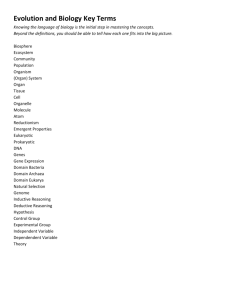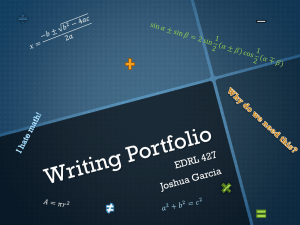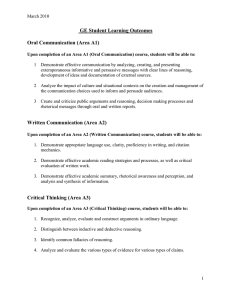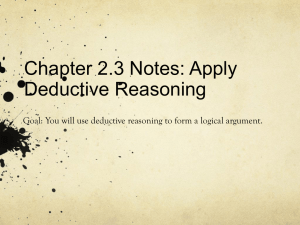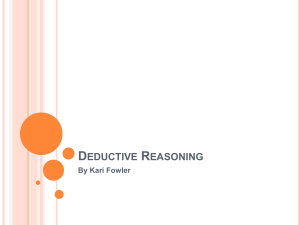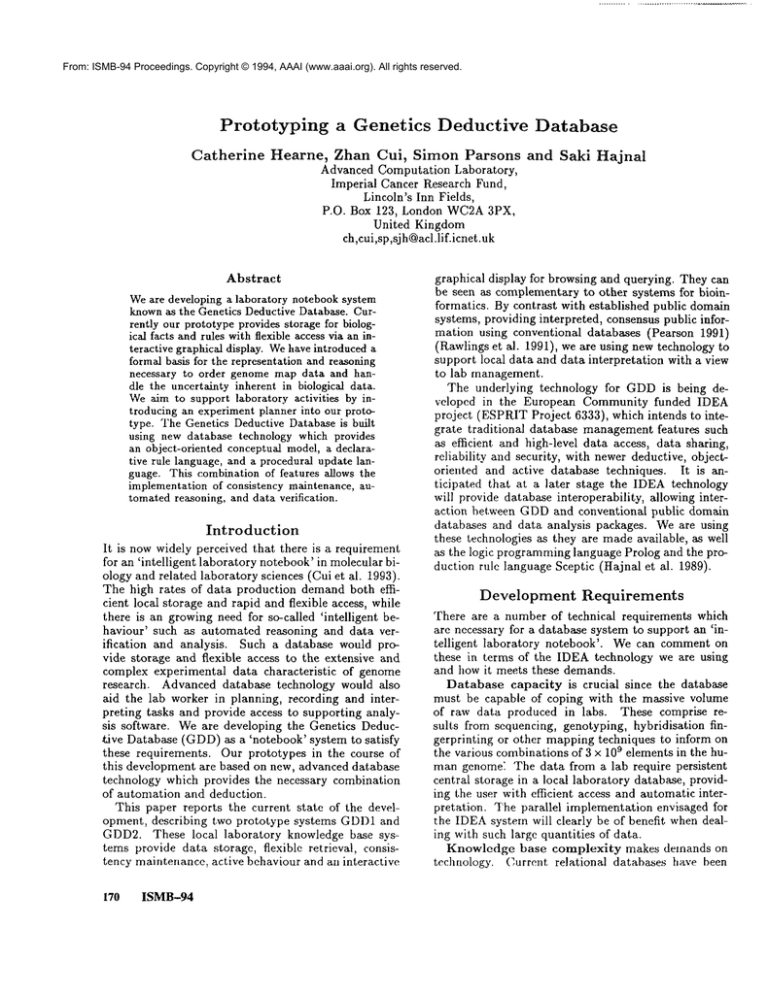
From: ISMB-94 Proceedings. Copyright © 1994, AAAI (www.aaai.org). All rights reserved.
Prototyping
Catherine
Hearne,
a Genetics
Weare developing a laboratory notebook system
knownas the Genetics Deductive Database. Currently our prototype provides storage for biological facts and rules with flexible access via an interactive graphical display. Wehave introduced a
formal basis for the representation and reasoning
necessary to order genomemap data and handle the uncertainty inherent in biological data.
Weaim to support laboratory activities by introducing an experiment planner into our prototype. The Genetics Deductive Database is built
using new database technology which provides
an object-oriented conceptual model, a declarative rule language, and a procedural update language. This combination of features allows the
implementation of consistency maintenance, automatedreasoning, and data verification.
Introduction
It is nowwidely perceived that there is a requirement
for an ’intelligent laboratory notebook’ in molecular biology and related laboratory sciences (Cui et al. 1993).
The high rates of data production demand both eff~cient local storage and rapid and flexible access, while
there is an growing need for so-called ’intelligent behaviour’ such as automated reasoning and data verification and analysis. Such a database would provide storage and flexible access to the extensive and
complex experimental data characteristic
of genome
research. Advanced database technology would also
aid the lab worker in planning, recording and interpreting tasks and provide access to supporting analysis software. Weare developing the Genetics Deductive Database (GDD)as a ’notebook’ system to satisfy
these requirements. Our prototypes in the course of
this development are based on new, advanced database
technology which provides the necessary combination
of automation and deduction.
This paper reports the current state of the development, describing two prototype systems GDD1and
GDD2.These local laboratory knowledge base systems provide data storage, ftexiblc retrieval, consistency maintenance, active bchaviour and an interactive
ISMB-94
Database
Zhan Cui, Simon Parsons
and
Advanced Computation Laboratory,
Imperial Cancer Research Fund,
Lincoln’s Inn Fields,
P.O. Box 123, London WC2A3PX,
United Kingdom
ch,cui,sp,sj h@acl.lif.icnet.uk
Abstract
170
Deductive
Saki
Hajnal
graphical display for browsing and querying. They can
be seen as complementary to other systems for bioinformatics. By contrast with established public domain
systems, providing interpreted, consensus public information using conventional databases (Pearson 1991)
(Rawlings et al. 1991), we are using new technology
support local data and data interpretation with a view
to lab management.
The underlying technology for GDDis being developed in the European Community funded IDEA
project (ESPRITProject 6333), which intends to integrate traditional database managementfeatures such
as efficient and high-level data access, data sharing,
reliability and security, with newer deductive, objectoriented and active database techniques. It is anticipated that at a later stage the IDEAtechnology
will provide database interoperability, allowing interaction between GDDand conventional public domain
databases and data analysis packages. Weare using
these technologies as they are madeavailable, as well
as the logic programminglanguage Prolog and the production rule language Sceptic (Hajnal et al. 1989).
Development
Requirements
There are a number of technical requirements which
arc necessary for a database system to support an ’intelligent laboratory notebook’. Wecan comment on
these in terms of the IDEAtechnology we are using
and how it meets these demands.
Database capacity is crucial since the database
must be capable of coping with the massive volume
of raw data produced in labs. These comprise results from sequencing, genotyping, hybridisation fingerprinting or other mappingtechniques to inform on
the various combinations of 3 x 109 elements in the human gcnome: The data from a lab require persistent
central storage in a local laboratory database, providing the user with efficient access and automatic interpretation. The parallel implementation envisaged for
the IDEAsystem will clearly be of benefit when dealing with such large quantities of data.
Knowledge base complexity makes demands on
technology. Current relational databases have been
designed from the requirements of simple applications
featuring simple data types and data structures. Biology is an area of complex knowledge, raising design
requirements for the knowledge base and for knowledge representation in the data model. The powerful
rule language supported by IDEAmakes it possible to
express this complex knowledge.
Formal specification is one approach to good design in building massive knowledge base support systems. For this it is necessary to design at the level
of tasks, domain datasets and inference methods, as
distinct from the lower level design of rules and facts.
For part of our prototyping work we make use of our
Specification Language for Object Theories (SLOT)
partnership with IDEAtechnology. This provides a design perspective and combines formal specification for
an object-oriented system with deductive and active
methods (Cui et al. 1993).
Object-oriented
conceptual modelling provides
a natural means of representing the complex, often
composite structures in molecular biology. The data
model groups objects into classes and subclasses which
share properties by inheritance,
a mechanism that
permits a superclass to confer its attributes and behaviours on its subclass. According to a recent paper
(Kochut et al. 1993), there are very few well-developed
examples of the use of object-oriented database systems in molecular genetics. This situation can only
be assisted by the development of robust technology,
and our use of IDEAtestbed systems suggests that,
when mature, this should offer a unique and suitable
platform for the development, of such systems.
Deductive rule languages provide inference in the
database and flexible information retrieval. These have
already been used in molecular biology, in the form of
the logic programming language Prolog (Kazic et al.
1990) (Yoshida et al. 1990) and in protein structure
prediction (Rawlings et al. 1985). Prolog has also been
successfully combined with object-oriented database
design (Gray et al. 1990). IDEAtechnology provides
a deductive database language less general than Prolog but which has the advantage of being integrated
with object-oriented and active functions and being
optimized for efficient database access. This is used
to derive values of object attributes and to implement
constraints defining restrictions on objects, classes, attribute values and legal states of the database.
Active behaviour is vital for an advanced data
handling system to respond to external events impinging on the database, such as the addition of data, user
queries and internal database events such as the violation of constraints. Such active behaviour is achieved
through event-oriented functions using data-directed
production rules or "triggers", and these are being
widely incorporated into relational, object-oriented
and deductive database products. These are used to
define specific reactions to particular events in the
database (Bayer 1993). IDEAtechnology makes trig-
gers available to the database designer, in the form
of event, condition and action specifications. The full
expression of triggers in the IDEAtechnology will allow the GDD2database to be programmed to respond
automatically to events and prevailing conditions as
desired.
Database interoperability
is required by GDD2.
This is the interaction of IDEAtechnology with conventional databases, allowing GDD2users access to
existing public data. Access to data stored conventionally means that new lab notebook systems do not
need to duplicate the public domain resources. We
hope that IDEAtechnology will provide this necessary
access through the approach of federated databases. It
is similarly undesirable to reimplement standard data
analysis software and it is preferable to provide interaction from advanced technologies.
Specialised reasoning methods are not supplied
by IDEAbut are required in our design to retrieve,
derive and manipulate genetic and other data stored
in the database. Morewill be said about these in later
sections. Here we can sunmlarise the basic requirements. Temporal reasoning is a necessary formalism
for the development of the GDD2system which offers representation and reasoning with genome maps.
Genomemaps can considered as linear orders of onedimensional intervals and distances between intervals.
These can therefore be represented by temporal logic,
especially interval logic (Guidi and Roderick 1993)
(Cui, 1994). For GDD2we are using an extended interval logic which supports the necessary partial orders, local orientation and distance. Weare working
on a special inference mechanismto exploit the spatial
structure present in these maps and to provide new inference rules like those described in CPROP(Letovsky
and Berlyn 1992). In addition we need a formal treatment for reasoning under the uncertainty of many of
these data, which can be incorporated into the map
representation language of GDD2.Weneed not only a
way to represent the associated imperfections of biological data, but also a method to reason with uncertain
or ambiguous data. The IDEA technology does not
support this activity and in order to do this we are
applying argumentation (Fox et al. 1993).
Genetics
Deductive
Databases
To date we have developed two prototype versions of
the Genetics Deductive Database, GDD1and GDD2.
GDD1,as the first version, reflected the limitations of
the early version of the IDEAtechnology with which
it was built. GDD2is the planned refinement of this
utilising a later more robust and advanced testbed from
the database technology development.
GDD1
GDD1represents our initial use of IDEAtechnology to
create a laboratory notebook system with active and
Hearne
171
deductive functions and a persistent knowledge base
(KB) for genetics laboratory and public domain data.
GDD1 Knowledge Base. The scientific
contents
of the GDDIknowledge base are laboratory observations, interpretations and theories. The scientific theories required to explain observations are general scientific knowledgeand account for and give structure and
context to lab observations. In particular the GDD1
KBconsists of genetic theories expressed as deductive
rules, facts such as sequence data, laboratory mapping
data and instances of associated concepts, experiments
and their components and interpretations of data, for
example, as genetic maps.
GDD1User Interface.
The GDD1graphical
user
interface provides an interactive display of the knowledge base schema. The class browser provides viewing, querying and editing of instances of classes in the
GDD1knowledge base, mediated by a graphical user
interface built in XPC,E (a user interface builder included in the ECLiPS~ logic programming system).
All display windows have window scroll bars and respond to the mouse, providing pop-up forms for completion and windowspecific or data spccific menus.
Interactive graphical objects respond to mouse movements by providing text, graphics, or with pop-up
boxes or menus. The class browser provides the menu
contents for each graphical object based on the relationships of objects and their attributes in the data
model. Figure 1 illustrates the user interactive session
with the graphical display. The queries for a display of
humanchromosome2 and details of regional map data
have been answered using public and private data and
the results displayed as interactive diagrams.
GDD1Functionality.
The GDD1interface
allows
the user to query and edit data, by graphical interaction or text entry, but not the database schema.
Queries can be issued concerning data from public
and private sources stored in GDD1including chromosomes, maps, markers and experimental data such as
genome analyses. Newdata can be added, interpreted
and displayed. Declarative integrity constraints are
used to express biological and physical laws concerning the data. These provide checks on the consistency
of the knowledge base contents and assist when new
data arc added and when inference from data is propagated within the database. For example new genotypc
data is checked for Mendelian inhcritance and sequence
data is checked for the correct base composition. In
GDDldata are stored temporarily before they are
subjected to checking and possible persistent storage.
IDEAtechnology provides a deductive database, and
GDD1uses passive deductive rules to propagate inference from data through the database. This provides
a dcgree of automation in the system, allowing data
intcrpretation
and update propagation. The declarative constraints also serve to detect inconsistencies in
172 ISMB--94
autonmted processes.
Automation is provided as active behaviour in the
form of production rules or triggers. These active rules
mayalso effect the propagation of inference, but require an event, such as storage of data, to fire an active rule. If a given set of conditions are true when
the triggering event occurs then the active rule is said
to be fired and a course of database action is initiated, for example to call an application program for
data analysis. Figure 1 is a snapshot of the GDD1system taken the momentafter an active rule is triggered.
IIerc the user is adding new data on family genotyping
which the system is checking data for consistency with
Mendelian Laws, using declarative constraints, before
ttmsc arc stored permanently. ’[’his prototype system
has been designed such that the conditions for the rule
to fire are that sutticicnt newand consistent data have
been added. The triggered actions include a message
to the user and the sinmlation of a call to an external
data analysis program.
The return of results from such a data analysis constitutes another triggering event. In this case the system interprets the results automatically as a new genetic mapwhich maybe stored. In the figure a dialogue
box allows the user to name this map in the database.
The addition of the new data may cause further triggers to fire. The final effects of this kind of active propagation in the knowledgebase cannot be forecast- -it
constitutes part of the intelligent activity of the system
we are building. It is easy to envisage cycles of triggering and propagation which do not require an external
connection and which may influence the user in a new
cycle of investigation and experiments.
GDD2
The GDD2system is a development from the GDD1
prototype and features improved technology and increased functionality.
GDD2will allow the user to
record details of lab activities, that is experiments or
procedures, as these are performed, and record their
results as they are observed. ’[he GDD2system will
provide representation and reasoning with raw experimental data to provide automatic analysis and a biologically useful interpretation in the database.
GDD2 Knowledge Base. The GDD2 knowledge
base consists of data specific to the domain, data concerning tasks such as experiments, analyses or access
to other database systems, and reasoning capabilities
using these data. The GDD2knowledge base should
support a wider and more detailed representation of
domain knowledge and lab practice than GDD1. In
particular, the GDD2knowledge base provides support
for a range of gcnome map representations including
cytogcnctic, contig, genetic, sequence and restriction
maps. GDD2also provides inference from these data to
enable reasoning in mapconstruction, to integrate data
from diverse sources and to give a systematic means of
,~11,,1
Figure 1: Snapshot of the GDD1User Interface
handling imperfect data. The GDD2model of laboratory experiments is being designed to provide scheduling for experimental processes and the managementof
lab resources such as reagents and equipment.
GDD2 Functionality.
In the GDD2 system the
user can record daily activity, rather as in a paper
notebook. The user will be able to query the GDD2
database for details of the methods and materials of
laboratory procedures and records of completed procedures and their outcome as observations and end products. Active rules in GDD2
enable the system to ~-ssist
in preparation and planning experiments and managing lab records by triggering automatic responses such
as checking reagent stocks and booking equipment. In
creating records for example, the system will create a
new instance of an experiment by automatically querying the knowledge base for details of that experiment
class and adding information such as reagents, input
material, creation date and time to the new instance.
In addition, a query to the system can remind the user
of a particular method, unusual reagent or safety hazard and anticipate the addition of new data. The user
interacts with the system during the experiment to enter data as observations are made, reagents are taken
from stock, equipment used, freed or occasionally broken. If an experiment is abandoneddue to early failure
the system must be informed and nmst roll back data
entry, plans and preparations already made.
Deductive rules in the system provide consistency
checking to ensure that data match the expected category for a given experiment, have the correct syntax,
and are consistent with the KBcontent. New data
must not introduce conflicting information although it
may be desirable to maintain conflicting data while
awaiting further experimental evidence. Also some allowance is required for the inherent ambiguity in experimental observations.
GDD2User Interface.
The GDD2 user interface
remains similar to that of GDD1,with the possibility
of reimplementing this in Tcl/Tk rather than XPCE.
Database Interoperability
Database interoperability is highly desirable for a laboratory notebook
system and the IDEAproject is addressing the general
question. Weare hopeful that GDD2will provide this
facility using future IDEAtechnology releases. This
would permit an extended definition of the functionality of the laboratory notebook. The external sources of
data and applications that are required include conventional databases and analysis programs in routine use
in the public domain. The user may require the knowledge base to query for data held at remote databases
and request services external to the application to complement and assist in local interpretation.
An example of this need was seen in the GDD1implementation, where sample data was obtained in part from the
GenomeDatabase (GDB, which is a SyBase system).
In a real lab situation, dynamic access to this data
would require an SQLinterface with the GDBserver.
Knowledge Representation
The data model for GDD2is both an expansion and a
refinement of the data model employed by GDD1,and
raises some interesting issues in knowledgerepresentation.
Hearne
173
Representing
Experiments
Laboratory observations are given their framework by
the daily activities of the experimenter who records
these data alongside the detailed description of the experiment in a paper notebook. Weare building an electronic version of this in the GDDsystem. As an active
extension, GDD2may provide support for the scheduling of experiments, as has been achieved in medical
decision support.
Currently we are using an object-oriented model to
describe tasks of varying complexity, generally consisting of composite activities,
as has been used by Baclawski et al. (1993).Each stage of a task is an activity
with associated conditions before and after, a set of input materials, duration and conditions, and results for
each stage in the form of material output and observations. For the purposes of the class hierarchy in GDD2
we have included processes as a class of experinaental_objects. These processes may be performed by lab
personnel and frequently consist of chemical or biological reactions, each involving a series of steps by which
substances are transformed from initial states to final
states. Within the biological domain we can also distinguish natural transformations such as growth and
cell division and disturbances to these, such as cancer, which is unregulated cell growth. These are useful
concepts for future extensions to the data model to
describe disease states.
In GDD2many instances of experimental process
will bc biological or chemical processes (or a combination). These maybe used in tasks and as part of testing
hypotheses, and experiments may also consist of mathematical or logical processes, for examplefor data analysis.Various kinds of equipment must also be modelled
for the user to record experimental processes such as
DNAsynthesis, centrifugation, refrigeration and heating. This also allows the system to provide automatic
stock control and reordering for items such as disposable plastic ware, such as microtitre plates and pipette
tips as is required for the biochemical substances participating in reactions.
A description of each experimental procedure is
stored in the database as a set of basic components
of the procedure and the higher order structures (experiment plans) into which they can be assembled.
This database of experimental methods can be queried
and modified by the user. These are automatically
retrieved when the user creates a new instance of an
experiment. The user may also wish to design new
experiments or steps in experinaents, and the system
must allow the creation of new combinations and new
components. As a first stage, active rules will allow
the system to react to the consumptionof reagents during experiments and trigger their automatic reordering.
Initially GDD2
is intended to provide a knowledgebase
as a reference source for experiment details which Inay
eventually support an active experiment planner.
174
ISMB-94
Representing
Genetic
Maps
Genomemapping is concerned with constructing an
ordered mapof genetic loci based on analysis of fragmentary ordering and metric data. Various methods
(Guidi and Roderick 1993) (Mott et al. 1993)
been used and the input data take various forms. In
general, a genetic database must be flexible enough to
support the diversity of raw data required by and the
interpreted data produced by different map construction algorithms. Someof the key requirements are:
supporting the concepts of partial order and distance,
accommodating uncertainty of measurement and ambiguity of results and handling local orientations and
derived data (Guidi and Roderick 1993). As far as
are aware, there is no system which meets all of these
requirements.
One of the difficulties is the lack of a suitable formalism to provide adequate representation and enable
the construction of inference rules to allow reasoning
with map data in the knowledge base.
The fact that most of the data related to genetic map
construction is one dimensional suggests that temporal
logic is a suitable formalism. Indeed, several systems
based on temporal logics have been built. Letovsky
and Bcrlyn (1992) use point set ontology for their
constraint-based
system CPROPwhich only uses one
relation B (before). Local ordering windows are introduced to handle different orientations and an int.eresting set of inference rules are formed to contruct
global ordering. Guidi and Roderick (1993) use Allen’s
(1983) interval-like logic to represent partial and uncertain ordering in DNAfragments but give no details
in their short survey paper. IIonda et al. (1993) propose an object-oriented data model which is also based
on temporal logic. Graves’ (1993) approach differs
using a general knowledge based system based on connection graph but the idea appears still to be based on
temporal logic.
There are some problems in using temporal logic in
that it is not entirely appropriate for maprepresentation and it makes no provision for uncertain data. In
addition, valuable metric information is not dealt with
in most temporal logics. Although both DNAfragments and probes can be viewed as intervals, they do
not. always have precise location information or known
distal extent. Partial orderings from experiments are
truc only in some local fraIne of reference whereas
in the temporal domain there is a simple global orientation. Manyexperiments, for example hybridisation approaches to physical mapping, are designed to
produce fragments overlapping to an unknowndegree.
These partial orders are also usually uncertain due to
unavoidable experimental error and conflicting orders
may result from different experiments.
In temporal logic, imprecise information is represented as disjunction of 13 mutually exclusive base relations. This is undesirable in our case because of the
computational cost of representing disjunction. What
Experiment1: PO(A,C):
c,
’ A[
Experiment2:B(C,B):
C[
Experiment
3: PP(B,A):
A[
Experiment
1 &2 &3:
[
~
A[
cl’
]
I
[ B[ ............. [
BD.............
CI
[ B[ ................[
AI
Figure 2: Diagram of Database MappingInference using Interval Logic
is needed is some higher order representation to cope
with the alternative possibilities of interval relations.
Recently, Freksa (1992) has used semi-intervals to represent this coarser knowledge but these relations do
not have a obvious hierarchy which we can use in our
data model.
The spatial logic described by Randell et al.
(1992) defines base relations by a single primitive
(connected 1) which can be represented in a hierarchy,
corresponding to the level of coarseness of knowledge.
For example, we may initially
only observe two DNA
fragments are connected, but not know whether they
are adjacent or overlapping without further experimentation. Randell et al.’s logic can be used to define all
the 13 interval relations in Allen’s logic by introducing only one primitive relation B(x, y); x being before
y. For the definitions of this logic and the complete
refinements see Randell (1991).
Our basic model for map objects has the same hierarchy as this spatial logic. Specifically, each node
represents a class of relations between mapobjects in
the database. ~Ve consider the two components ’local orientation’ and ’distance’ (representing the two
regions or fragments) as map object class attributes.
The lowest level of information is represented in the
root class (corresponding to weakest relation in the
logic,) where the relation between two fragments is unknown. The highest level of information is encoded by
the leaf nodes where the precise relation between two
fragments is known.In our particular model, the fragments can be genetic entities such as DNAfragments,
chromosomes,probe, clone and restriction sites as well
as partial maps. Partial maps are represented in GDD2
as tuple linked lists, where each tuple consists of left
and right pointers and the current fragment and heterogeneous maps are represented by multiple instances.
In this way we are representing the coarseness of our
knowledge about two DNAfragments in a general refinement hierarchy.
In this model, the inferences used in deriving new
data and constructing maps are based on reasoning on
1 Informally, two regions are connected if they share a
point in common.
the topological relations. Binary relations represented
as metric data (known map distances) can be translated into topological relations in order to reason with
these data in the knowledge base. From this logic we
are able to develop a set of inference rules, similar to
those of CPROP(Letovsky and Berlyn 1992) but making use of more information and thus allowing greater
powers of deduction.
In the example shown in Figure 2 we show how deduction in the GDD2knowledge base can operate on
the data from three separate experiments (1, 2 and
3). In this case we are not considering metric data,
only order relations. In all three loci (A,B and C) are
studied and their data entered into the system. Experiment 1 reveals a partial overlap between A and C
: PO(A,C), which mayhave the two local orientations
as shown. Experiment 2 informs the worker that locus C lies before B : Before(C, B), and Experiment
detects that locus A contains locus B, expressed as B
is a proper part of A : PP(B, A). The automated deduction carried out by the system can reason, as thc
worker would, that there is only one solution for the
local orientation, as shown.
Each partially ordered set of fragments in the knowledge base is associated with a local orientation. Constructing a new partial order out of two partially ordered fragments presents a problem of ambiguity in the
data which requires further use of the inference rules
and the maximal utilisation
of available data. The
GDD2system, through the use of IDEA technology
and reasoning methods to supplement this, is attempting to provide a high degree of automated deduction
and propagation of inference. These are necessary elements in the formation of an intelligent system for
molecular biology.
Representing
Imperfect
Data
Throughout the design and implementation of the Genetics Deductive Database we have been aware that
biological data are characteristically imperfect (Allison 1993), and that some mechanism nmst be provided in order to represent these imperfections. There
are a number of different issues concerning imperfection (Motro 1992) including inconsistency, where labs
Hearne
175
give differing results to the same question, ambiguity,
where more than one interpretation is possible, and incompleteness, where values for attributes do not exist
in the data for whatever reason.
Whenimperfect, data nmst be appropriately marked
and handled in the knowledge base, data analysis and
the propagation of updates. Inconsistent biological
data are relatively commonand their resolution must
often await further results. In cases wherea decision is
needed on inconsistency, some criterion must be used
to favour one of the competing pieces of data. Similarly, it will be necessary at times to disambiguate data
to obtain an interpretation that fits with other related
information. Such conclusions drawn may require revision at any time. Incomplete or missing data can be
handled in a numberof ways--it is possible to fill in the
gap with some reasonable assumption, explicitly represent the fact that the item is missing, or discard the
item with the missing value (Mott et al. 1993)--while
the uncertainty surrounding data must be propagated
and communicated to the user.
Manyof the problems in representing imperfect information have been addressed. The usual approach
to handling uncertainty is to attach some numerical
measure, typically a probability, to every fact (Barbara et al. 1990). This permits the certainty of information to be represented in a reasonably intuitive
way. Vague and ambiguous data may be modelled using fuzzy predicates (Buckles and Pctry 1987) which
permit the expression of the degree to which given attributes have values. Inconsistent and incomplete information can be addressed’ by the provision of null
values (Imielifiski and Lipski 1984), or by applying
methods from non-monotonic logic (Ginsberg 1987)
fill in the gaps. Such techniques mayalso be applied
to resolve inconsistency by specifying default choices,
and any implementation of a non-monotonic method
will require some forIn of truth maintenance system
(Doyle 1979),(de Kleer 1986) to ensure consistency
reasoning progresses. For example, newly derived data
from reasoning processes mayrequire an update of the
database which includes removing previously derived
data no longer held to be true.
Thus if we wish to handle all these different aspects
of imperfection, we will either need to combine a number of different techniques together in some way, as
argued by Umano(1983), or to use a means of representing imperfection that can be applied to all the
different varieties. Weare doing the latter, adopting a
method of argumentation (Fox et al. 1993).
Argumentation provides a general framework for
representing knowledge that is closely related to the
notion of labelled deductive systems (Gabbay 1990),
and extends the usual logical notion of what constitutes an argument. In classical logic an argument is a
sequence of inferences that lead to a conclusion. The
basis on which the conclusion is reached is implicitly
the rules of inference of the logic and the full set of
176 ISMB--94
facts that are knownto the reasoner. Fox et al. (1993)
describe a logic of argumentation LA which extends
this idea by annotating the conclusion with an explicit
statement the set of facts that are used in the deduction, the reason for believing the conclusion, and the
degree to which the conclusion is believed. The triple
of conclusion, the degree of belief and the reason for
believing it are called an argument. LA clearly generalises classical logic, but goes further since the degree
to which the conclusion is believed can bc stated numerically, or symbolically to represent for examplethat
a piece of information is from an authoritative source.
Argumentation also allows the representation of inconsistent and non-monotonic information. Inconsistency, which defeats normal logical methods, may be
handled because LA inakcs it possible to represent and
resolve the conflicts caused by inconsistency. Thusit is
possible to express the idea that a conclusion is rebutted, whenit is possible to construct an argumentthat
has the opposite conclusion. Since the stages in reaching a conclusion are also represented, as the ’reasons
to believe’ it is also possible to record the fact that
there are arguments against these, in which case the
conclusion is said to be discounted. By considering all
thc possible discounting and rcbuttings that may be
derived, an overall conclusion may be reached. The
fact that an existing conclusion can be rebutted by a
new one, derivable from new data, makes LA capable
of non-monotonic reasoning.
Within GDD2,LA can be used to represent the support for database facts by makinguse of its ability to
handle any kind of object as a degree of belief. LA can
also be used to handle missing information, since it is
possible to represent explicitly the fact that a value
has been used in the absence of information, and it
can be used to manage inconsistency by providing a
mechanism for deciding which of the various options
has the most support. Thus it seems suitable for the
representation of most kinds of imperfection that are
necessary in GDD2.
As an example of the simplest use of LA we consider
an example cited by Guidi and Roderick (1993). They
discuss combiningorder and distance data from various
experiments. LA allows the representation of the arguments for and against a combination of interpretations
of the data in Figure 3 from five partial mapsof a chromosome.LA allows the propagation of a record of the
support for particular genetic maps when they are combined, for exampleusing interval logic, and in resolving
the inconsistency between different maps. Combining
the results of Experiment 1 and Experiment 2 gives
Map 3. Since the map obtained from Experiment 3
disagrees with that of Experiment 2, which is one of
the stcps in obtaining Map3, Experiment 3 discounts
Map3. Similarly, thc experiment that generated Map
5 rebuts Map3. Thus, assuming that all the results
are equally valid, Map5 should be preferred to Map3.
Weare also working on the evaluation of the strength
a
a
a
b
x
b
x
Y
Map 1
Experiment 1
Map 2
Experiment2
Map 3
Experimentl,
Experiment2
Map 4
Map 5
Experiment3
Experiment4
Figure 3: Inference with genetic maps
of arguments for reasoning with these kinds of contradictory data by attaching measures that reflect the
quality of the results.
Conclusions
and Future
Research
In conclusion we can say that the GDD1system clearly
illustrates the potential for active behavioursin providing automated assistance to the database user and that
the IDEAtechnology has the potential to satisfy this
requirement. The IDEAtechnology being provided in
the project for developing GDD2is stronger and has
optimized query functions to improve the overall performance of the application.
The GDD2system adds
considerably to the reasoning capability of the knowledge base as well as improving its content. We are
confident in the utility of the interval logic inference
rules and the representation of the imperfections in
the mapping data. The modelling and management
of experiments is an area of ongoing effort. Initially
at least, GDD2is focussing on a foundational knowledge base for experimental methods and materials for
the active managementof resources rather than personnel. With later versions of IDEAtechnology GDD
should provide a usable laboratory notebook system
for molecular biology.
Acknowledgements
This research was partly supported by the European
Commission under ESPRITProject 6333 IDEA(Intelligent Database Environments for Advanced Applications). This paper reflects the opinions of the authors
and not necessarily those of the consortium.
References
Allen, J. 1983. Maintaining Knowledge about Temporal Intervals. A CMTransactions on Dalabase Systems
26(11):832-843
Allison, L. 1993. Methods for Dealing with Error and
Uncertainty in Molecular Biology Computations and
Data-Bases. In Proceedings of the 26th Hawaii International Conference on System Sciences, 604-604.
Baclawski, K., Futrelle, R., Fridman, N., and Pescitelli,
M. 1993. Database Techniques for Biological Materials
and Methods. In Proceedings First International Conference on Intelligent Systems for Molecular Biology,
21-28.
Barbara, D., Garcia-Molina, H., and Porter, D. 1990.
A Probabilistic Relational Data Model. In Proceedings
of the 1990 EDBTConference, 60-74.
Bayer, P. 1993. State-Of-The-Art Report on Reactive Processing in Databases and Artificial Intelligence.
The Knowledge Engineering Review 8(2):145-171.
Buckles, B. C., and Petty, F. E. 1987. Generalized Database and Information Systems, In Anaysis
of Fuzzy Informalion, Volume 2, J. Bezdek (ed.), CRC
Press.
Cui, Z. 1994 Using Interval Logic for Order Assembly
In Proceedings of the Second Intcrnational Conference
on Intelligent Systems for Molecular Biology (This volume)
Cui, Z., Fox, J., and Hearne, C. 1993. Knowledge
based systems for molecular biology: the role of advanced technology and formal specification In Proceedings of the IJCAI Workshop on AI and the Genome
87-97.
Doyle, J. 1979. A Truth Maintenance System. Artificial Intelligence 12:231-272.
Fox, J., Krause, P., and Elvang-Gcransson, M. 1993.
Argumentation as a General Framework for Uncertain
Reasoning. In Proceedings of the Ninth Conference on
Uncertainty in Artificial Intelligence, 428-434.
Freksa, C. 1992. Qualitative Spatial Reasoning In
Cognilive and Linguistic Aspects of GeographicSpace.,
D.M.Markand A.U.Frank (ed.s), Kluwer, Dordrecht.
Gabbay, D. 1990. Labelled Deductive Systems, CIS
Technical Report 90-22, University of Munich.
Ginsberg, M. 1987. Readings in Nonmonotonic Reasoning. San Mateo, CA: Morgan Kaufmann.
Graves, M. 1993. Integrating Order and Distance Relationships from Heterogeneous Maps In Proceedings
First International Conference on Intelligent Systems
for Molecular Biology, 154-162.
Gray, P., Paton, N., Kemp,G., and Fothergill, J. 1990.
Hearne
177
Anobject-oriented database for protein structure analysis. Protein Engineering 3:235-243.
Guidi, J. and Roderick, T. Inference of Order in Genetic System. In Proceedings First International Conference on Intelligent Systems for Molecular Biology,
163-169.
Hajnal, S., Krause, P., and Fox, J. 1989 Sceptic User
Manual Technical Report 95, Advanced Computation
Laboratory, Imperial Cancer research Fund.
tIonda, S., Parrott, N., Smith, R., and Lawrence., C.
1993 An Object Model for GenomcInformation at All
Levels of Resolution. In Proceedings of the 26th Hawaii
International Conference on System Sciences, 564-573
Imielifiski, T., and Lipski, W. 1984. Incomplete Information in Relational Databases Journal of the A CM
3 I(4):761-791.
Kazic, T., Lusk, E.,Olson, R., Overbeek, R., and
Tuecke, S. 1990. Prototyping Databases in Prolog In
The Practice of Prolog, Leon Sterling (ed.) Cambridge,
Mass:: MIT Press.
de Kleer, ,I. 1986. An Assumption-based TMS.Artificial Ialelligence 28:127--162.
Kochut, K., Arnold, J., Miller, J., and Potter, W. 1993.
Design of an Object-Oriented Database for Reverse
Genetics. In Proceedings First International Conference oil Intelligent Systemsfor Molecular Biology, 234242.
Letovsky, S. and Berlyn, M. 1992. CPROP: A RuleBased Program for Constructing Genetic Maps. Genomics 12:435-446
Motro, A. 1993. Sources of Uncertainty in Information Systems, In Proceedings of the 2nd Workshop
on Uncertainty Managementand Information Systems,
Catalina Island.
Mott, R., Grigoriev, A., Maier, E., ltoheisel, J., and
Lehrach, It. 1993. Algorithms and Software Tools
for Ordering Clone Libraries. Nucleic Acids Research,
21:1965--1974
Pearson, P. L. 1991. The genome database (GDB)
- a human genome mapping repository Nucleic Acids
Research 19:2237-2239
Rande]], D. 1993. Analysing the familiar. Reasoning
about space and time in the everyday world. Ph.D
Thesis University of Warwick 1991
Randell, D., Cui, Z., and Cohn, A. 1992. An Interval
Logic for Space based on ’Connection’. In Proceedings
of the 10th European Cortference on Artificial Intelligence, :~94-398
Rawlings, C., Taylor, W., Nyakairu, J., Fox, J., and
Sternberg, M. 1985. Reasoning about protein topology
using the logic programming language Prolog Journal
of Molecular Graphics 3:151 157.
Rawlings, C. J., Brunn, C., Bryant, S., Robbins, R. J.,
Lucier, R. E. 1991. Report of the Informatics Committec Cytogenctics and Cellular Genetics 58:1833-1838
Umano, M. 1983. Retrieval from fuzzy database by
fuzzy relational algebra. In Proceedings of tile IFAC
Symposium, 1-6.
178 ISMB--94
Yoshida, K., Smith, C., Kazic, T., Michaels, G., Taylor, R., Zawada, D., Hagstrom, R., and Overbeek, R.
1992. Toward a [fuman GenomeEncyclopedia In Proceedings of the International Conference on Fifth Generation Computing Systems, 307-320.


